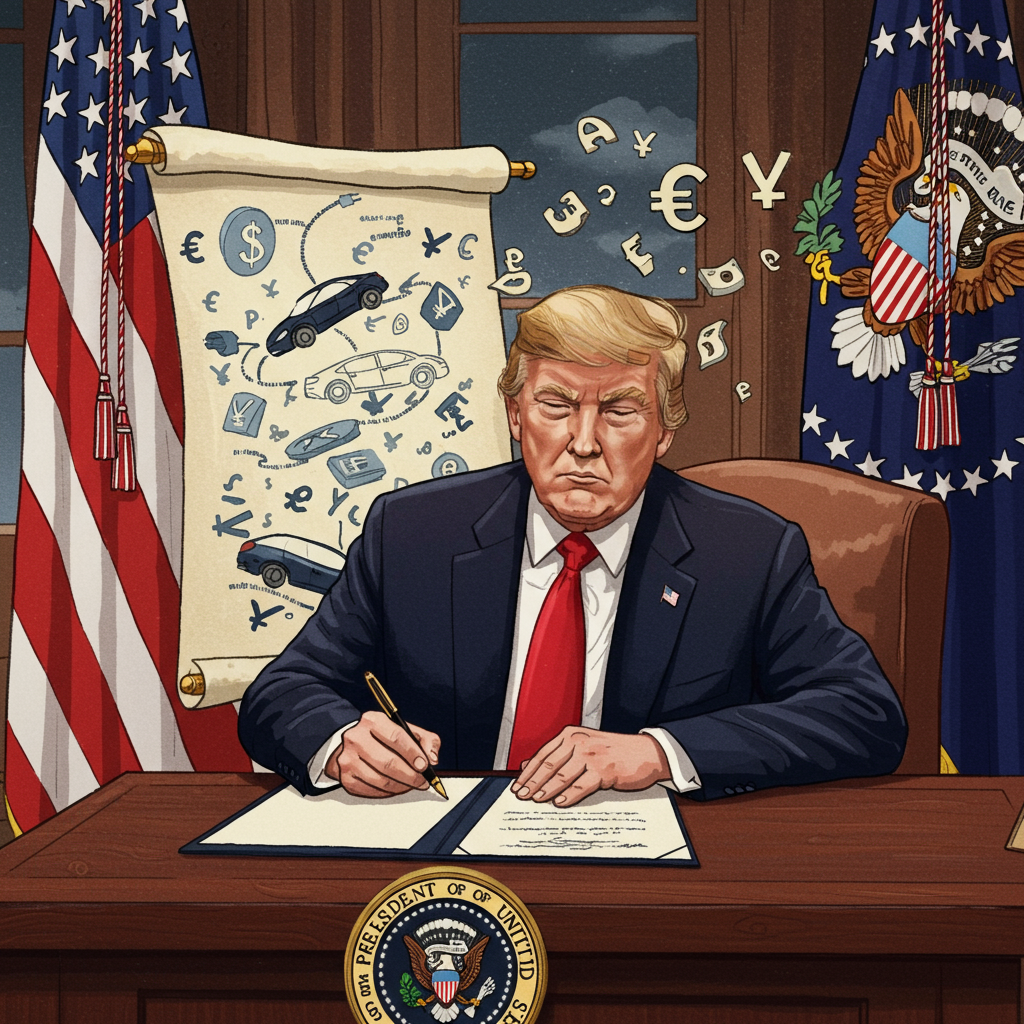Major changes to federal incentives for electric vehicles (EVs) are here. A significant tax-and-spending package, officially titled the “One Big Beautiful Bill Act,” championed by President Donald Trump and recently signed into law on July 4th, will dramatically shorten the lifespan of valuable EV tax credits. If you’ve been considering purchasing or leasing an electric vehicle, a critical deadline is fast approaching that could save you thousands of dollars.
This new legislation repeals the federal tax credits established under the Inflation Reduction Act (IRA) much earlier than planned. Instead of lasting until 2032, the $7,500 credit for new EVs and the $4,000 credit for used EVs are now set to expire after September 30, 2025. This creates a limited window for buyers and lessees to take advantage of the federal incentives that have helped make electric mobility more accessible.
The Impending September 30 Deadline
The passage of the “One Big Beautiful Bill Act,” which narrowly cleared the Senate by a 51-50 vote with Vice President JD Vance casting the tie-breaking decision, sets a firm cutoff date for federal EV tax benefits. This timeline is notably more aggressive than earlier proposals, including an initial House version that would have extended the credits until the end of the year.
Potential EV owners must now prioritize their purchasing decisions. Ingrid Malmgren, a senior policy director at Plug In America, emphasized the urgency, stating that this summer will be the key period for EV purchases. She warned that if the law remains unchanged, the credits will vanish at the end of September. To claim the credit, consumers must ensure they physically take possession of the vehicle by the September 30 deadline. Malmgren specifically advises utilizing the point-of-sale tax break option offered by dealerships, rather than waiting to claim it on your annual tax return the following year.
What the Bill Does to EV Incentives
Under the previous Inflation Reduction Act framework, the federal government offered incentives designed to lower the cost of EVs and accelerate their adoption. This included a credit of up to $7,500 for eligible new clean vehicles and $4,000 for eligible used clean vehicles, with certain manufacturing and battery sourcing requirements.
The new “One Big Beautiful Bill Act” effectively eliminates these specific federal credits after the September 30, 2025 cutoff. This shift marks a significant change in federal policy aimed at incentivizing cleaner transportation, impacting future purchase decisions and the overall affordability of electric cars for many Americans.
Why Federal Credits Mattered for EV Adoption
Federal tax incentives like the $7,500 credit have played a crucial role in bridging the cost gap between electric vehicles and traditional gasoline-powered cars. Historically, new EVs have carried higher upfront price tags. For instance, data from May shows the average new EV priced around $57,700 before subsidies, compared to about $48,100 for gas cars, according to Kelley Blue Book. While used EV prices ($36,000) were only slightly higher than used gas cars ($34,000) in May, the $4,000 used credit offered a substantial relative discount.
Researchers at the University of Michigan highlighted in 2024 that these federal incentives “play a pivotal role in accelerating the break-even point” where the lower operating costs of EVs (maintenance, fuel) offset their higher initial purchase price compared to gasoline vehicles. By lowering the entry cost, credits encourage more consumers to consider EVs, which aligns with environmental goals.
The Environmental and Economic Context
The transportation sector represents the largest source of greenhouse gas emissions in the United States, accounting for roughly 28% of the total, according to the Environmental Protection Agency. Shifting to electric vehicles is a key strategy for reducing these emissions, as fully electric cars produce zero tailpipe emissions.
While the manufacturing and charging processes for EVs do involve some emissions, studies like those from the Massachusetts Institute of Technology confirm that EVs are “unambiguously better for the climate” than gasoline cars even when considering their full lifecycle impact. Making EVs more financially appealing through incentives has been a core component of climate policy, a role now set to diminish at the federal level.
Beyond the Federal Incentives
Even with the federal tax credit ending, the financial picture for EV buyers isn’t entirely bleak. Experts note that state and local tax incentives may still be available depending on where you live. These can vary significantly, offering rebates, tax credits, or other perks that can help offset the cost.
Furthermore, the market dynamics for used EVs are projected to change. A substantial wave of leased electric vehicles is expected to enter the secondhand market over the next few years. Approximately 1 million EVs were leased between early 2022 and early 2025, with a significant surge in lease returns anticipated starting in 2025 and peaking around 2027. This increased supply could potentially lead to lower used EV prices, providing an alternative form of affordability for buyers even without the $4,000 federal credit. While a larger supply might benefit buyers, the loss of the used credit still removes a direct incentive that previously cushioned the cost.
Context: The ‘One Big Beautiful Bill’ Act
The decision to cut the EV tax credits is part of a much larger legislative package. The “One Big Beautiful Bill Act” encompasses broad changes to tax policy, spending priorities, and social programs. Analysis by groups like the Institute on Taxation and Economic Policy (ITEP) indicates that the bill’s tax provisions, which largely extend the 2017 tax cuts, are heavily weighted to benefit higher-income households, particularly those in states without state income taxes who are unaffected by the $40,000 cap on State and Local Tax (SALT) deductions.
The bill also includes significant increases in spending on areas like border security (funding for new wall construction, ICE agents) and defense (missile defense, Mars mission funding), alongside changes to social safety net programs such as stricter work requirements for Medicaid and SNAP benefits. Critics argue the bill’s overall structure disproportionately favors the wealthy while potentially harming lower-income individuals through social program adjustments. The elimination of the EV tax credit, originally aimed at broader adoption, occurs within this context of legislative priorities.
Other Provisions and Market Changes
The “One Big Beautiful Bill Act” touches on numerous other areas, including deductions for tips, overtime, and a senior bonus (though experts note these are structured as deductions, limiting benefits for low earners with little taxable income), taxes on wealthy university endowments, and adjustments to Social Security taxes for older Americans.
Meanwhile, the electric vehicle market continues to evolve rapidly, independent of this specific federal credit change. Innovations are progressing in battery technology, vehicle efficiency (like Lucid’s focus on range from smaller packs), and alternative electric transport forms (electric boats, hydrogen aviation). Global markets are seeing shifts, with countries like Ethiopia banning new gasoline car imports entirely to boost EV adoption and address fuel import costs. This broader context highlights that while the U.S. federal incentive landscape is changing, the global push towards electric mobility persists, driven by varied factors including environmental concerns, technological advancements, and shifting national priorities.
Frequently Asked Questions
What is the ‘One Big Beautiful Bill’ and how does it affect EV tax credits?
The “One Big Beautiful Bill Act” is a major legislative package recently signed into law by President Trump. It includes wide-ranging changes to taxes, spending, and social programs. Specifically for electric vehicles, it repeals the federal tax credits of up to $7,500 for new EVs and $4,000 for used EVs established under the Inflation Reduction Act. This means these credits will no longer be available after a specific cutoff date instead of continuing through 2032 as originally planned.
When exactly does the federal EV tax credit end under this new law, and what should potential buyers do?
Under the “One Big Beautiful Bill Act,” the federal tax credits for both new and used electric vehicles are set to expire after September 30, 2025. This means that to be eligible for the credit, a buyer or lessee must take physical delivery of the vehicle on or before this date. Experts strongly recommend that anyone hoping to use the credit complete their purchase or lease and take possession well before the deadline, ideally utilizing the point-of-sale option offered by dealers to claim the benefit immediately.
Why is the federal EV tax credit being eliminated, and what were its original goals?
The elimination of the federal EV tax credit is part of the broader policy shifts within the “One Big Beautiful Bill Act,” which prioritizes different spending and tax reduction measures. The original goal of the federal EV tax credit, particularly under the Inflation Reduction Act, was to incentivize consumer adoption of electric vehicles by making them more affordable. This was intended to help reduce greenhouse gas emissions from the transportation sector, a major contributor to climate change, by lowering the financial barrier to choosing cleaner vehicles.
Conclusion
The passage and signing of the “One Big Beautiful Bill Act” represent a significant shift in federal policy regarding electric vehicle incentives. With the $7,500 new and $4,000 used EV tax credits set to end after September 30, 2025, the window for potential buyers to take advantage of these federal savings is rapidly closing. While state and local incentives may still exist and the used EV market is expected to see an influx of inventory, the loss of the federal credit removes a major financial factor that has supported EV adoption. Anyone considering an electric vehicle purchase or lease who planned to rely on the federal incentive should understand the impending deadline and make their decisions accordingly.
Word Count Check: 985



